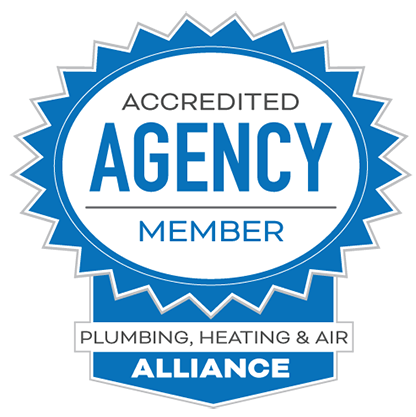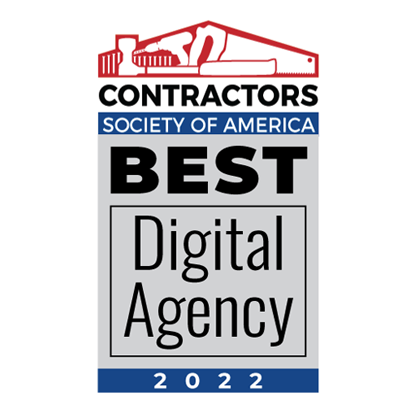When I launched HVAC Webmasters – my SEO agency for HVAC Contractors in 2013, I could not have predicted the industry’s current state.
Industry-altering technological advancements (like AI) and algorithmic efficiency (i.e., Google’s Helpful Content Update) have turned search engine optimization upside down.
I’ve always prided myself on staying ahead of the curve, so research, data, and development are the pillars of my agency’s growth and service offerings.
SEO should not be a secret set of strategies hoarded by the industry’s elite, but rather a collaborative journey shared with everyone, especially heating and cooling professionals throughout the United States.
That’s why I am presenting my comprehensive guide to SEO for HVAC companies in 2025 based on 15+ years in the industry.

Nolen’s Key Takeaway
As the founder of the most tenured SEO agency for HVAC companies in the United States, I can confidently say that SEO remains the most effective marketing strategy for heating and cooling professionals.
What is SEO for HVAC Companies?
SEO, or Search Engine Optimization, is currently the best way for HVAC companies to acquire local customers and build company awareness.
Effective SEO ensures your business appears above your competition on platforms like Google, ChatGPT, Bing, and Yahoo.
SEO applies to Google Search, Google Maps, AI Platforms, social media networks, and any digital asset where a consumer can find a company or brand.
How SEO Changed
SEO has changed significantly in the past five years, from consumer behavior to the emergence of artificial intelligence.
Here are the three primary ways that search has evolved:
- AI: Google’s AI platform, Gemini, and OpenAI’s ChatGPT have fundamentally changed SEO.
- Algorithm updates: Examples include the Helpful Content and March Core Updates, which have altered the SEO landscape.
- Search Evaluator Guidelines: EEAT: experience, expertise, authority, and trustworthiness.
- Search Behavior: Fewer people are following the traditional search query – website click- conversion path, as people are increasingly performing zero-click searches and brand awareness research across multiple platforms.
While the algorithm will still value factors like content quality, link authority, and on-page optimization, the standards for legitimizing your website and its content will rise considerably.
Today, HVAC sites must be well-written, provide a good user experience, and offer unique information to rank on SERPs.
An SEO-friendly website must also include schema markup, precise metadata, images, videos, and media that match the discussed topic.
Pro Tip: Jobsite check-ins help HVAC websites appear in Google’s new AI Overviews

Why SEO Remains Important for HVAC Contractors
When someone in your area needs a service or product, they still use a search engine, such as Google, ChatGPT, or even Reddit.
If a consumer searches for “A/C repair in Dallas, TX,” lists of companies, relevant content, and information will appear in some form.
With AI, that will likely include specific HVAC companies mentioned in the AI-generated response.
With Google Search or Google Maps, you will see a list of businesses with links to their websites or Google Business Profiles.
Applying effective SEO tactics will help your company be among those mentioned or listed. Prominent search visibility leads to more inquiries, appointments, and business awareness for your HVAC company.
Properly implemented SEO can mean the difference between a fruitful customer base and closing the doors for good in today’s digital landscape.
SEO Strategy: The Planning Stage
Your SEO strategy should not be done on the fly or without thought. Effective SEO is well-planned and utilizes research.
While your SEO plan should include well-researched keywords, it’s also essential to understand the limitations of “keywords” in modern SEO.
Most HVAC keywords are long-tail, meaning they won’t register a search volume with these tools.
The goal of keyword selection is to identify words that will attract the most relevant searchers. Using MOZ and SEMrush, identify each word’s search volume, difficulty, and competition level.
Understanding which services are frequently searched for helps you map out your service pages.
From there, you will use software and digital brand signals to rank for long-tail keywords on these pages.
National Keywords
High-volume keywords like HVAC Repair, Air Conditioner Installation, and Heating Services are indexed according to the searchers’ location, so local businesses aren’t competing nationally for these terms.
Identifying these top terms will also help when considering more specific longtail and service-related terms that pinpoint even more relevant searches.
Top keywords like these should be the primary keywords on your service pages to be indexed effectively and help SERP ranking.
Local Keywords
Local queries typically include a location identifier, such as the city name, after the primary keyword.
For instance, if you’re an HVAC company in Wilmington, DE, local homeowners may search for terms like “AC Repair Wilmington” or “Wilmington Central Air Installation.”
Depending on the size of your target city, there may not be a high search volume for keywords that include such location identifiers. However, this doesn’t mean nobody is searching for them.
Pro Tip: Over 90% of all Google searches are for long-tail and low search volume terms.
Service Keywords
Although the primary HVAC services fall under the umbrella of national keywords and often register significant search volume on SEMRush, other lesser-known services may not register such volume.
Still, like with local keywords, these are valuable terms to rank for and will generate clicks and conversions.
Services like walk-in freezer repair and mini-split AC system installation are worthy of dedicated pages even if they don’t register an official search volume.
URL Structure & Page Hierarchy
Once you compile your list of target keywords, you can set up your URL structure and page hierarchy.
Typically, sites have multiple pages that present information from a general to a more specific level. The organization of those pages is called the site or page structure.
Top Level Pages
Most HVAC websites have a top-level Home page, an About Us page, a Contact Us page, and a Reviews page. They may also have a few top-level general service pages, such as “Heating” or “Air Conditioning.”
These pages are typically included on your homepage’s main navigation menu, which makes it easy for search engine crawlers to access and index quickly.
Example: https://yourhvaccompany.com/about-us
Second Level Pages
From there, HVAC sites lead into secondary pages that may include categories for specific HVAC services like “Central A/C Service,” “Furnace Service,” or “Central Heating.”
These URLs are nested underneath a parent category, like Heating or Air Conditioning, and usually link back to that page internally.
Example: https://yourhvaccompany.com/heating/furnace-repair
Third Level Pages
The third level of pages branches into subcategories, which address niche services like “Natural Gas Furnace Repair” and “Ductless A/C System Installation.”
Your third-level pages must have plenty of internal links from the higher-level pages so that search engine crawlers can find them.
Example: https://yourhvaccompany.com/heating/furnace-repair/natural-gas/
Hierarchy Optimization
Your site structure should be straightforward and help Google index your pages for search rankings. The pages should flow nicely into each other and create a natural flow process for reaching them.
You should carefully consider the URL structure and your HVAC site’s page hierarchy. It is critical to map out each URL, followed by Google and searchers.
The URLs should be concise, presenting the exact topic and a clear path to the information.
Images & Videos
Younger homeowners spend their time on predominantly visual platforms like Instagram and TikTok, which increases the importance of visual media within your SEO strategy.
HVAC websites should select original photos and videos during the planning stage to emphasize the content properly and prevent duplicate usage.
In addition to your website and each of its pages, your Google Business Profile Images should also be unique and reflect your business, staff, and services.
Search Engine Optimization: The Implementation Stage
Once you have finished your SEO plan, you should have a clear layout of your site’s page structure along with keywords, images, videos, and URLs.
Even with a perfectly crafted plan, the ultimate success of your SEO strategy depends on implementation.
In this part of the process, you will need the assistance of a website designer, preferably one with experience in the HVAC marketing industry.
Custom Design
While multiple usable templates are available for your HVAC site, a custom website design is always best regarding SEO and searchability.
Templates lack the coding that Google uses to index information and keywords. A customized site design is needed to implement fundamental structure and coding details like schema, headers, and title tags.
Experienced HVAC web designers understand where to place calls to action to drive on-site conversions.
Contact Information
A lack of easy-to-access contact information is among the most significant contributors to low conversion rates.
Your HVAC site should have listed contact information on every site page, including a location address and map, phone number, and email address.
Your company’s phone number should also appear throughout the content for maximum usability.
Call To Action
Any marketer worth their salt will tell you that a call to action is crucial.
Your page’s call to action leads, instructs, and inspires your site’s visitors to complete the desired action, whether to schedule an appointment or call for more information.
Your calls to action should be easy to find and conveniently located within the page to maximize usability and task completion, sometimes called goal completion.
Website Personalization
Your company website reflects the business itself. Your design should represent your HVAC company’s personality.
If your HVAC business focuses on commercial service, you want a professionally presented site with structure and uniformity.
However, if your company has a laid-back approach, you may want to use a broader color scheme or more vibrant design elements.
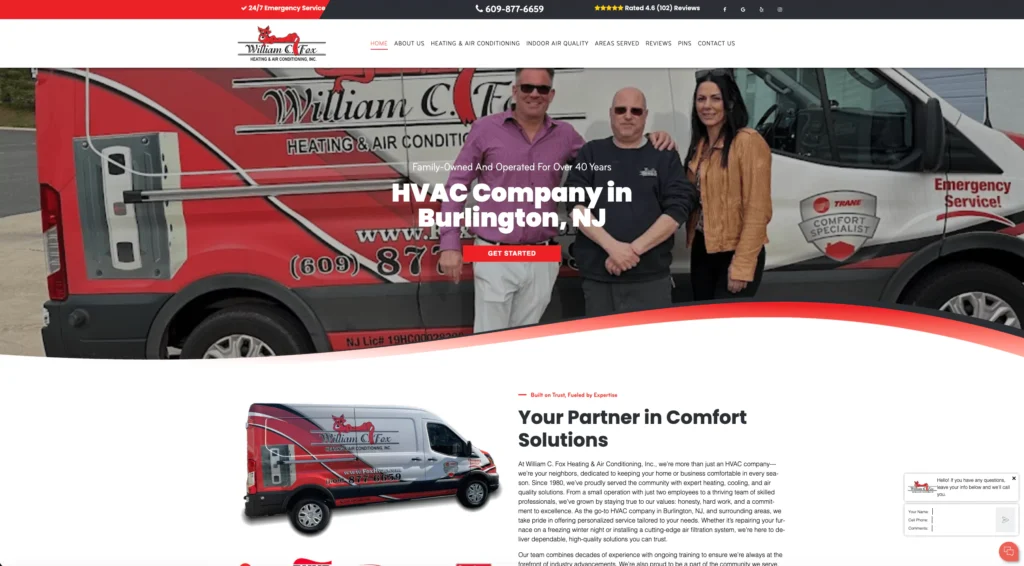
Badges, Accolades, and Testimonials
You work to get certifications and certificates that set you apart from your competition.
Ensure that your site visitors know how skilled you are by displaying badges and accolades prominently with links back to the original site.
Social proof communicates your abilities to prospective customers and provides outward-facing opportunities to reputable sites within your industry.
Google’s emphasis on E-E-A-T directly ties visual proof to SEO performance and ranking potential.
Testimonials also help promote your company by providing positive, real-life experiences to your visitors and potential customers.
You can display testimonials on your HVAC website and your Google Homepage to encourage searchers to choose your company.

Multimedia Content
In today’s online landscape, multimedia content, including videos, social media embeds, PDFs, or other interactive options, is the best way to hold user attention.
Along with providing backlinks and sharing options that boost online trust and reputability, these additions create a better user experience, leading to lower bounce rates and higher conversion rates.
Multimedia content is also perfect for sharing on secondary platforms like YouTube or social media, providing backlinks and distribution opportunities.
Pro Tip: Upload a company video to YouTube, embed it on your website, and share it on Facebook.
Mobile Optimization
Google fully rolled out mobile-first indexing in July of 2024, making all HVAC websites dependent on the quality of their mobile design.
HVAC websites that utilized Responsive Web Design (RWD) benefited most from this transition as their site appeared optimally across all devices.
However, sites stuck using outdated technologies will have trouble ranking on Google search going forward.
Local SEO for HVAC
Most HVAC companies serve local customers within a defined service area. For example, your company is based in the Phoenix metro area and serves Phoenix, Glendale, Peoria, and other nearby cities.
You also want your website to appear in “near me” and map searches for consumers in these cities.
Local SEO for HVAC companies is achieved through multiple tasks and techniques, and can offer the boost you want to outdo your competition.
DataPins
Jobsite check-ins from DataPins are the single most effective local SEO strategy for my clients.
I often say that HVAC keywords have more variations than Sonic drink flavors because there are so many combinations that people search for.
DataPins validates each HVAC job you perform and its location and converts your service description into an SEO-friendly blurb that results in a digital hand raise.
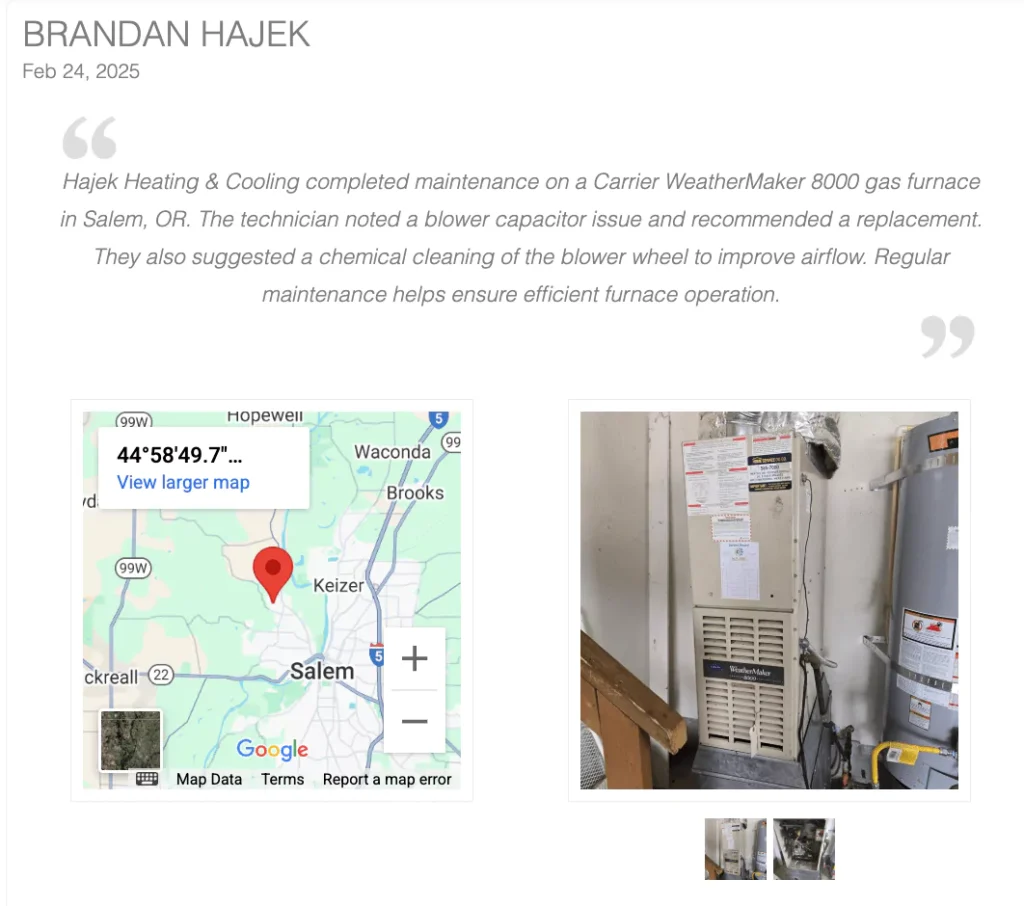
Local Business Citations
Citations are listings or mentions in other locations throughout the web that help build trust and recognition.
Local directories, such as Angi, Yelp, and HomeAdvisor, are notable sources of proper citations that can boost your SEO.
Conversely, you should ignore citations from spammy and low-quality directories because they are not indexed by Google, which means they don’t transfer any ranking equity.
NAP Consistency
One way to boost your local SEO efforts is to ensure your NAP, or Name, Address, and Phone number, is consistent throughout the web.
Your company name and contact information should be consistent across all sites where your business is listed.
NAP consistency helps Google and other search engines easily associate your location with your other business listings, which enhances your credibility and online presence.
Google Business Profile Optimization
When searchers perform a branded search or a search of your company name, Google typically shows your Google Business Profile.
The profile contains contact information, reviews, ratings, hours, and any images or Google Posts you added.
Your Google Business Profile is eligible to rank within the Local Map 3-Pack and Google Maps results.
City Pages
City pages are dedicated location pages for individual cities. HVAC websites often produce dozens or even hundreds of city pages.
While this strategy can work, it can also violate Google’s Helpful Content Update if the pages are thin and low quality.
If you deploy this tactic, include job site check-ins on each location page and contain 100% unique content relevant to the precise city.
City pages should have unique content, images, and SEO elements and provide a clear overview of your company’s offerings.
Title tags, including a top keyword and a location tag, should be used within the content to give optimal indexing to the specified area.
This way, when users perform a location-based search, such as “heater repair in Palmdale, CA,” your Palmdale city page is displayed in the search results.
On-Page SEO for HVAC Companies
On-page SEO provides Google context about each page’s intent, displayed through meta tags, images, bullet points, headers, and other styling and formatting techniques.
Google uses these details to determine what type of content is available on your site and where you’ll rank on SERPs.
Google delivers rankings on the page level, meaning your most relevant page to the user’s query should appear (assuming there is no technical SEO error).
Keyword Placement
Keyword placement remains crucial for helping Google understand your page’s context and topical relevance.
Your primary keyword for each page should appear within the title tag, H1, URL slug (if possible), and the first paragraph of the page’s body content.
Avoid overusing that keyword in other parts of the page, as the sections I’ve outlined are more than enough to provide Google and other search engines with the context it seeks.
Throughout the rest of your page, follow these guidelines:
- Use Keyword Variations (Sometimes Called LSI Terms)
- Use Natural Language (or NLP style writing)
- Format Pages With a Topical Hierarchy
Google’s modern algorithms are more intelligent than mere keyword recognition. They incorporate entity recognition and topical depth more than the old-school concept of keyword density.
Title Tags
Title tags influence your rankings more than any other SEO lever.
An ideal HVAC title tag includes:
- Primary Keyword
- Local Context (i.e., City Name)
- Brand / Company (When Useful)
- 60 or Fewer Characters (to avoid SERP Shortening)
Example: AC Repair in Plano, TX | JimBob’s Mechanical
Remember to align your content and formatting (headers and topical hierarchy) with your title tag’s intent so that users “get what they came for.”
Google’s algorithms can detect when a title tag misleads the reader and is likely to reduce its ranking.
Meta Descriptions
While meta descriptions have a negligible impact on SEO rankings, they do impact click-through rates (CTR), an indirect ranking factor.
A suitable HVAC meta description contains:
- Clear and Compelling Messaging
- 150-160 Characters
- Primary Keyword
Example: JimBob’s Mechanical Offers Efficient and Reliable Air Conditioning Repair Services in Plano, TX. Our Trained Staff Members Provide 24/7 Emergency Services!
Header Tags
Header tags create a topical hierarchy that helps visitors and search engines understand your page.
The best practices for HVAC page headers include:
- Use Only One H1, Which Should Either Match or Closely Resemble Your Title Tag
- Use H2s and H3s for Main Sections and Subsections
- Keep Headers Between 20-70 Characters
- Utilize Secondary Keywords When Applicable
Well-structured header tags help your pages rank in traditional search results and in Google’s AI Overviews.
Google uses headers when generating AI responses and summaries for specific search queries.
URL Slugs
A URL slug (or permalink) is the end part of your page URL.
For HVAC websites, a URL slug should be:
- Concise
- Descriptive
- Keyword-rich
- Hyphen-seperated
- Lowercase
Bad URL Slug: myhvacwebsite.com/page?id=342492433432131
Good URL Slug: myhvacwebsite.com/services/gas-furnace-repair
While URL slugs might seem insignificant on the surface, they actually have a significant impact on how search engines interpret your pages, including in the context of the rest of your website.
Image Alt Text
Alt text is essential to image indexing on Google and other search engines and can also help your pages rank higher in organic and AI search results.
Image Alt text for HVAC websites should:
- Clearly Describe The Image’s Content
- Include Relevant Keywords Where Applicable
- Avoid Keyword Stuffing
Alt text should be reserved not only for the images you hope to rank but for every image file on your website to build topical relevance sitewide.
Alt Text Example: Tech Repairing AC Unit in Plano, TX
Images with accurate and descriptive alt text may appear in featured snippets and AI-generated responses.
Other SERP Ranking Factors
Google and other search engines use various information and details to provide helpful search results for their users.
While on-page and site-wide SEO is crucial, other factors also affect your business’s ranking. Instead of a singular tipping point, a collection of elements influences SERP position.
Domain Age
Your site and domain age are also factors that Google considers when presenting search results.
A site that is ten years old is more established than a site that is six months old and will hold more clout on SERPs.
It’s essential to keep your domain once you have one. A well-established domain displays a reputable web address and not a “fly-by-night” site that helps with ranking.
Reviews
Reviews also impact how your brand is reflected on SERPs.
As your clients leave reviews of your company on different platforms, Google indexes them to measure your reputation.
Reviews are also displayed on your Google knowledge panel, showing prospective clients what level of quality they can expect from your company.
The knowledge graph displays many more review types than Google alone, so it’s vital to encourage your clients to complete reviews on multiple platforms, such as Facebook, Angi, and HomeAdvisor, for comprehensive coverage for your HVAC business.
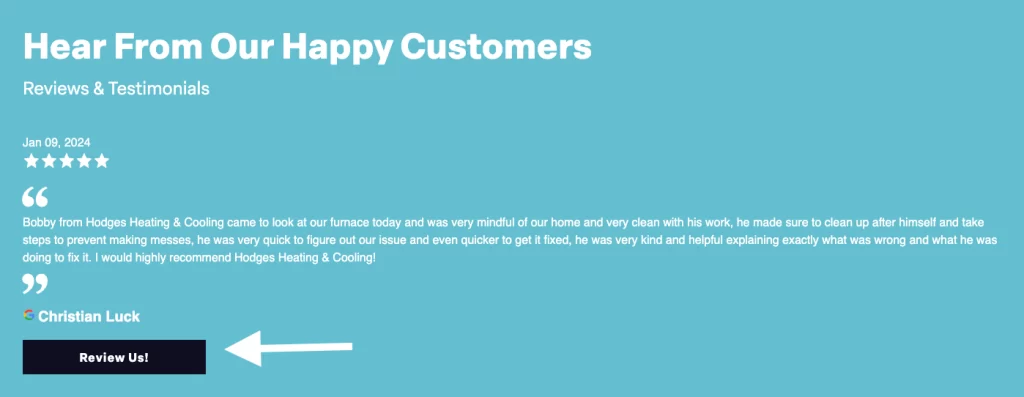
Location
Your business location directly impacts how well your Google Business Profile ranks within the Map 3-Pack.
If your address is on the outskirts of a city or in a Census Designated Place (CDP), you will get fewer Google Maps impressions.
Conversely, an address near the city’s center (or centroid, as Google Maps defines it) can help you quickly generate impressions, even as a newer HVAC company.
Measuring SEO Success
As with any business plan, your SEO campaign should be tracked through analytics to ensure its effectiveness.
Luckily, Google and many other programs offer helpful tools for measuring your SEO success.
Google delivers first-class analytics, enabling you to create valuable and productive progress reports.
Google Analytics
Google Analytics is Google’s proprietary tracking platform. It allows HVAC companies to measure website performance through various metrics, including users, organic visits, and direct visits.
While the latest version, GA4, has a slightly steeper learning curve than the previous version, it remains the most accurate and insightful platform for tracking SEO performance.
Google Business Profile Insights
With your Google My Business account, you can access Google Business Profile Insights to help track your local performance.
This platform tracks metrics like calls from Google Business Profile, website clicks, and impressions.
GBP insights also lists common terms or phrases that prompt your profile to appear in search results.
Google Search Console
Google Search Console is another Google tracking platform tailored explicitly to organic search performance.
While it doesn’t track other visitors (like Google Analytics), it provides highly accurate and valuable insights into your organic search performance.
With GSC, HVAC companies can evaluate which pages are being clicked on via organic search and which queries are being used to find them.
3rd Party Tracking Tools
Platforms like SEMRush, Moz, and Ahrefs provide helpful metrics and analytics that help you judge the effectiveness of your marketing plan.
However, these tools are not as accurate as Google’s because they rely on estimates rather than raw internal data.
That’s why you should avoid solicitations from marketing companies that evaluate your website performance only using third-party tools.
Next Level SEO Tips for HVAC Companies
Google’s recent algorithm updates, including the Helpful Content Update, have increased the power of E-E-A-T or expertise, experience, authoritativeness, and trustworthiness.
Heating and cooling websites that best demonstrate these qualities through branded signals will rank.
SEO remains the most affordable method of generating HVAC leads online. However, some tactics that previously led to consistent rankings on search engines are no longer viable.
As a result, HVAC companies must adapt to maintain or increase their Google visibility.
Tip 1: Implement Digital + Branded Signaling
An HVAC company website should not aim to trick search engines but rather establish a brand that search engines can trust enough to present to its users.
The most effective way to achieve this is through E-E-A-T, which can be automated using DataPins.
Another way to foster branded signaling is to create user content rather than search engine content.
As a result, those hundreds of thin blog posts your marketing company published on your HVAC website are counterproductive to search engine optimization.
Tip 2: Create Multi-Channel Brand Synergy
While a robust website is the most integral part of an SEO strategy for HVAC professionals, it’s not enough to establish a viable brand for your services.
Your other digital entities, like your Google Business Profile (formerly Google My Business) and social profiles, should also link to your website.
For example, consider Google Maps and YouTube, as both platforms are now integrated within Google search results.
Ensuring your HVAC company can rank on Google’s Local Map 3-Pack, video carousel, and traditional organic results epitomizes SEO synergy.
Tip 3: Optimize for User Intent
Google’s priority is its users (those searching for HVAC services). As a result, you must view your website as Google’s partner and something that can help satisfy their users’ search experience.
If a local HVAC prospect searches for gas furnace repair services, they intend to find content that clearly outlines gas furnace services through expertise and experience.
User intent also applies to the website’s location, as local homeowners seek contractors who can reasonably commute to their homes.
Tip 4: Embrace The Future of AI Search
Google shows AI Overviews within their search results, and more homeowners are asking ChatGPT about HVAC companies.
Getting your company mentioned in these AI-generated answers will be the basis for the future of SEO.
Tools like DataPins, along with a multi-channel marketing campaign, can help increase your mentions in these AI-generated responses.
Next Steps for HVAC Companies
The emergence of AI tools like ChatGPT has sparked spirited conversations about the future of SEO for lead generation.
As a top-rated marketing agency for HVAC companies throughout the U.S., our internal data shows that SEO is here to stay.
As the owner of a heating and cooling business, investing in SEO starts with a simple call to an agency like HVAC Webmasters.
If you prefer to do SEO yourself for now, the first step is claiming and optimizing your Google Business Profile so you can appear on Google Maps.
However, when you need a comprehensive SEO strategy with the industry’s highest implementation standard, reach out to me for a free consultation.


